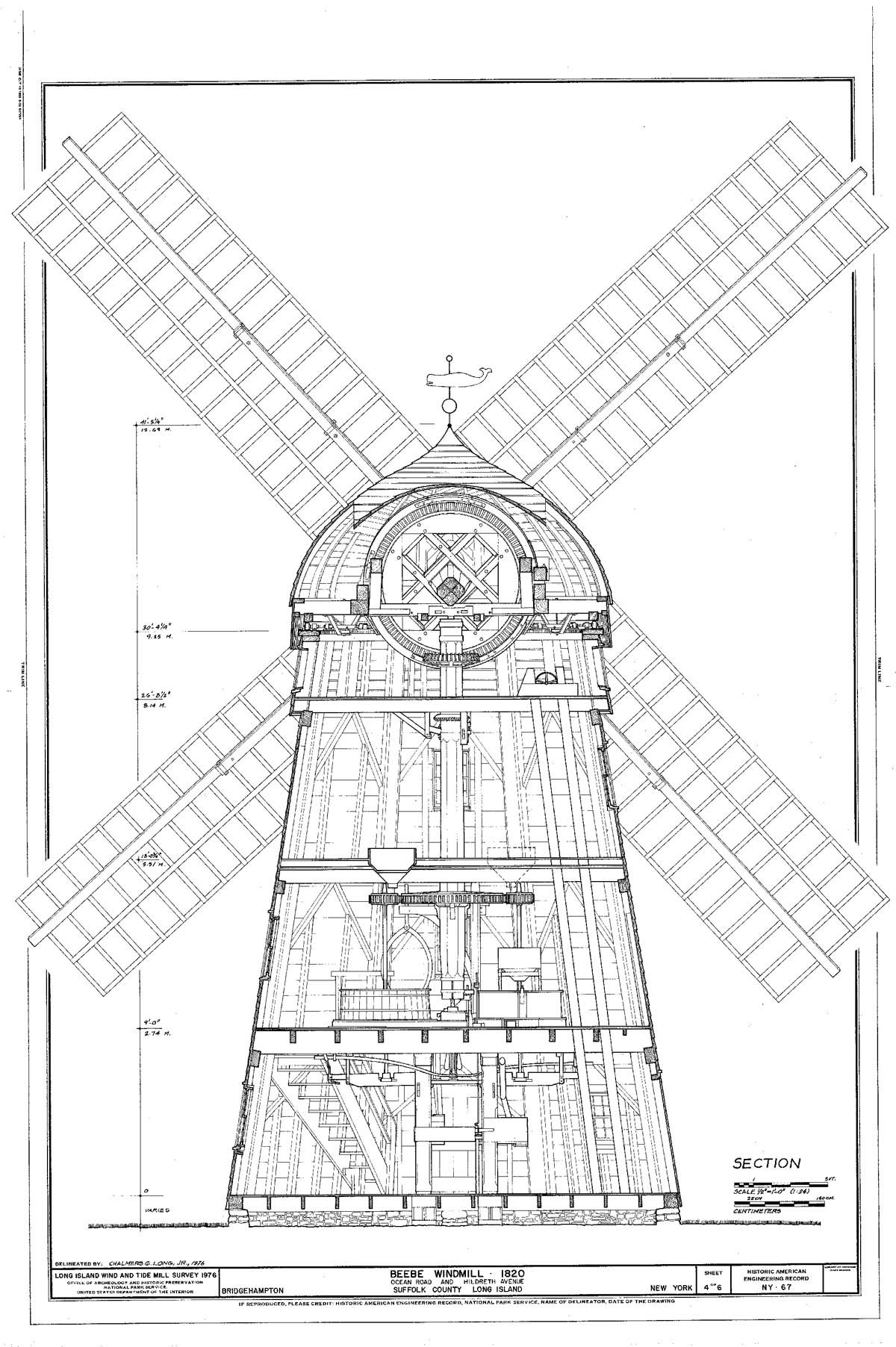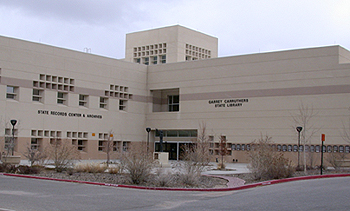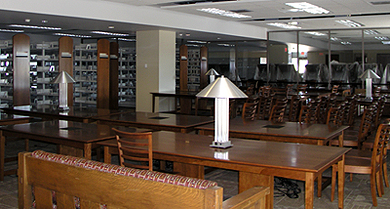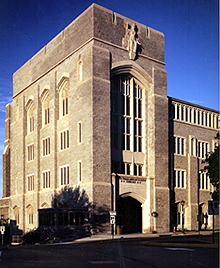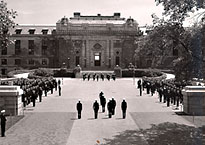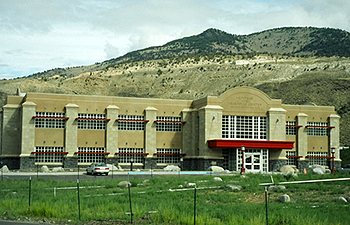
NARA's Oldest Partnerships
Summer 2006, Vol. 38, No. 2
By Diane Vogt-O'Connor
While most Americans know that the National Archives and Records Administration (NARA) is based in Washington, D.C., and more are becoming acquainted with the regional archives, few know that NARA first provided access to its original federal records outside of Washington more than a half-century ago.
In 1953, the Archivist of the United States approved the U.S. Military Academy (USMA) as an affiliated archives after the Army's adjutant general requested that the official federal records created by the USMA stay at West Point.
Since then, the academy's federal records have been made available on the West Point campus, near related USMA materials such as manuscripts, personal papers, and museum and library holdings.
In the last 53 years, the USMA has been joined by seven other archival repositories in NARA's oldest partnership program: the affiliated archives.
Who Are NARA's Affiliated Archives?
Before the establishment of affiliated archives, all accessioned federal records were available only at the National Archives Building in Washington, D.C., or on microfilm. By partnering with federal and state institutions, the National Archives recognized that it should serve the most significant audiences for a group of records, even when the audience was outside of the nation's capital.
Affiliates provide an enriched research setting that may include related archival, library, and museum holdings. In some cases, the records are found in the very buildings, campuses, and ecosystems to which the records refer, making them even more useful. Using their own specialized knowledge, buildings, equipment, and resources, affiliates add value to the research, educational, and archival management processes. In effect, NARA gets expert partners who use their repository's resources in support of NARA's mission. Affiliates are an intoxicating mix of significant records, major research audiences, expert colleagues, and new opportunities.
Of the eight affiliated archives, five are federal agencies, and three are at state-operated institutions.
The Historic American Engineering Record (HAER)
Created in 1969 by the National Park Service, the Library of Congress, and the American Society of Civil Engineers, HAER's mission is to document America's significant industrial and engineering sites. The structures range from aqueducts and bridges to factories, forts, lighthouses, and windmills.
The Library of Congress and the National Park Service have been affiliates for HAER since 1975. The National Park Service creates the HAER records, which are later transferred to the Prints and Photographs Division of the Library of Congress for preservation and access. The HAER holdings at the Library of Congress document almost 8,000 American structures and sites associated with commercial, military, public, and transportation activities, chiefly from the 18th to 20th centuries. These records include almost 150,000 measured and interpretive drawings, large-format black-and-white and color photographs, and written histories of engineering achievements in the United States and its territories.
Electronic images for over 90 percent of the HAER holdings are available through the Library of Congress's web site. Researchers can search online by name or address of a structure, its location, and often by engineer or other creator's name, the owner's name, building date, and current and/or former use of the structure (such as a trolley barn). A diverse audience, including the general public, educators, and historians in many disciplines, heavily use the holdings at the Library of Congress. The availability of the technical drawings and photographs helps researchers explore our nation's engineering heritage in practical and creative ways.
New Mexico State Records Center and Archives (NMSRCA)
The NMSRCA has been an affiliated archives since 1972 for the General Land Office Records called the "Spanish Land Grant Archives." Dating back to 1682, these are some of NARA's oldest records. They document New Mexico's tumultuous history during the Spanish (1598–1821) and Mexican (1821–1846) eras, when land was granted to both individuals and communal groups including settlers and Pueblos. After the Pueblo Revolt of 1680 destroyed many Spanish land documents, the legal ownership status of much New Mexican land became clouded, making the remaining records documenting land ownership invaluable.
Under the U.S. occupation of New Mexico, the Treaty of Guadalupe-Hidalgo in 1848 established that U.S. law would recognize earlier Spanish and Mexican land grants. The U.S. Office of the Surveyor General of New Mexico was established in 1854 to investigate land grant claims and make recommendations to Congress on their validity.
The Spanish Land Grant Archives records consist of over 72 cubic feet of Record Group 49, Records of the Bureau of Land Management; many documents were created between 1682 and 1846 but were obtained in 1855 by the Surveyor General of New Mexico in support of claims. The series also includes records created and acquired by the U.S. Surveyor General (1885–1890) and the U.S. Court of Private Land Claims (1891–1903). These federal records are still heavily used. Most recently,
- the Center for Land Grant Studies used the records to create 16 land grant summaries that contain document-level citations;
- the New Mexico Office of the State Historian used the federal records to create online exhibits;
- the Online Archives of New Mexico described the records on the web; and
- the affiliated archives posted electronic copies and descriptions of the records on their web site and in the Online Archives of New Mexico.
The archival holdings are located in a state building in Santa Fe, New Mexico, where they are used by educators, lawyers, students, and other researchers on land grants, land ownership, boundaries, and Southwestern history.
Oklahoma Historical Society (OHS)
The OHS, founded in 1893, is both a private membership organization and a state agency dedicated to the preservation and interpretation of Oklahoma and Southwestern history. On March 27, 1934, less than three months before the National Archives was created, an act of Congress transferred 2,100 cubic feet of federal historical records of Oklahoma's Indian tribes to the OHS.
The federal records in the OHS repository document 67 American Indian tribes that are either indigenous to Oklahoma or were forcibly removed for resettlement within Oklahoma from east of the Mississippi during the l9th century. The records include 3.5 million pages and 6,000 bound volumes from U.S. Indian agencies in Oklahoma (1870–1933); national records of the Cherokee, Chickasaw, Choctaw, Creek and Seminole Nations (1860–1906); and Dawes Commission records. The federal records also document the Cheyenne and Arapaho Agency, the Cantonment Agency, the Chilocco Indian School, the Kiowa Indian Agency, the Mekusukey Academy, the Pawnee Indian Agency, the Quapaw Indian Agency, the Shaw
nee Indian Agency, and the Executive Library of the Cherokee Nation.
These federal records are actively used by tribal members and genealogists attempting to trace their American Indian ancestry; educators and students of Oklahoma history; curators and designers; scholars, writers, and publishers; filmmakers and television producers; web content site creators and publishers; and many others. In spring 2006, the affiliated archives moved into the new Oklahoma History Center facility, a 215,000-square-foot learning center, located directly across from the State Capitol.
Pennsylvania State Archives (PSA)
Since 1995 the PSA has been NARA's smallest affiliated archives for the "Records of Brevet Major General John Frederick Hartranft as Special Provost Marshal for the Trial and Execution of the Assassins of President Lincoln." Part of NARA's Record Group 393, U.S. Army Continental Commands, 1821–1920, these records were transferred to NARA's ownership during a legal dispute in the 1990s and then placed on permanent loan to the PSA to ensure that the records could remain in the context of the John Frederick Hartranft Papers. Hartranft, a Pennsylvania governor and general during the Civil War, was charged with the custody and trial of the Lincoln assassination prisoners and their execution.
The federal Hartranft records include an order book, a letter book, and 51 unbound items (e.g., correspondence and orders) from and to military officers and high government officials. These records document the operation of the military prison and inmate care from April 14, 1865 (immediately after the assassination of President Lincoln), through the trial and hanging of convicted Lincoln assassins Louis Paine, George Atzerodt, David Herold, and Mary Surratt on July 7, 1865.
U.S. Government Printing Office (GPO)
In August 2003, NARA and the Government Printing Office (GPO) signed an agreement to establish an affiliated relationship. This agreement ensures that the documents available on GPO Access, the GPO web site that provides free online public access to more than 250,000 federal government titles, will be available permanently. Although other affiliated archive agreements evolved over time to include electronic records, this agreement was the first of its kind between NARA and another government agency to specifically address electronic government records. The content of GPO Access includes the online versions of the Congressional Record, the Federal Register, the Code of Federal Regulations, and other electronic publications distributed by the Superintendent of Documents.
United States Military Academy Archives at West Point (USMA)
West Point is America's oldest continuously occupied military post, having served as George Washington's headquarters during the Revolutionary War. The military academy was established there in 1802, during the presidency of Thomas Jefferson. The academy's original focus was on civil engineering, and USMA graduates built much of the early American infrastructure (bridges, harbors, and roads). West Point graduates served in the highest ranks in all American wars. The academy set up its first official archives in 1946, and affiliation with NARA followed in 1953.
The USMA archives collection consists of more than 1,500 cubic feet of past administrative records of the academy, dating from its founding in 1802 through the present, including manuscripts, typescripts, publications (the cadet yearbook, Howitzer; the post newspaper, Pointer View; Annual Reports of the Superintendent; and others), photographs, sound recordings, and maps. These records form NARA's Record Group 404, Records of the United States Military Academy. The USMA archives also holds related NARA microfilm publications. USMA archives holdings are supplemented by nonfederal special collections including personal manuscripts of Academy alumni and some non-graduate papers, as well as rare books from the 16th–18th centuries and other publications. In 2005, the USMA archives had 2,226 remote reference requests and 967 on-site visitors, of whom 363 were from outside the USMA.
United States Naval Academy William W. Jeffries Memorial Archives (USNA)
In 1825 President John Quincy Adams called for a naval academy "for the formation of scientific and accomplished officers." Twenty years later, on October 10, 1845, the Naval School at Annapolis opened for classes, and in 1850 the Naval School became the U.S. Naval Academy.
The USNA archives was established in 1970 to collect, preserve, and make accessible the historical records of the Naval Academy and has been an affiliated archives since 1985.
The records, part of Record Group 405, Records of the United States Naval Academy, include superintendent's correspondence from 1845, Academic Board and Board of Visitors records, midshipmen personnel jackets, conduct and academic records, yearbooks and other publications, official directives, faculty records, records of the academic departments and administrative offices, records of the reserve officers training programs during World War I and World War II, and records of special courts of inquiry. Audiovisual holdings include architectural drawings; films, maps, photographs, and videotape recordings of events; and audiotape recordings of speeches given by prominent visitors, including U.S. Presidents. The USNA special collections also hold records gathered by the Naval Academy Alumni Association that document the post-graduate naval careers of alumni.
The Naval Academy's federal records support classroom presentations, curriculum development, institutional history initiatives, and individual student and faculty research projects as well as a wide variety of external projects.
Yellowstone National Park
On March 1, 1872, President Ulysses Grant designated Yellowstone's 2.2 million acres of wilderness as the world's first national park. By 1886, concerns about poaching and vandalism led the Department of the Interior to ask the U.S. Army to occupy the park. In 1916, President Woodrow Wilson signed into existence a new government agency, the National Park Service, which began managing the park in 1918. Yellowstone has been an affiliated archives for the records of the park, part of Record Group 79, Records of the National Park Service, since 1979.
The affiliated holdings total approximately 2,000 cubic feet of federal records, including bound volumes; charts, drawings, maps, and plans; photographs, glass plates, negatives, prints, slides, and transparencies; and traditional textual records, such as park correspondence. Some of the holdings are microfilmed.
In 2004 Yellowstone's archives welcomed 1,500 researchers, half of whom were staff members and half of whom were from the public sector. In 2004–2005, the archives moved to a new facility, the Yellowstone National Park Heritage and Research Center, which also holds the park library, museum holdings, scientific laboratories, and a cultural center. At Yellowstone National Park, researchers benefit from the expertise of the park historians, archivists, librarians, and other cultural and natural resource professionals available for consultation. As the park archivist, Harold Housley, notes, "The park archives' status as a NARA affiliate adds prestige to the collection."
NARA's affiliated archives are NARA's oldest and most faithful partners. Working together with NARA staff, the affiliated archives meet the needs of the American public for authentic and useful records on some of the most compelling topics in America's history from military academies, presidential assassinations, land grants, and American Indian tribal membership and relocations to historic preservation and the world's first national park. NARA invites you to explore its affiliated archives.
Diane Vogt-O'Connor is chief of the Conservation Division at the Library of Congress. Until May 2006 she was senior archivist for regional and affiliated archives at the National Archives and Records Administration's Office of Regional Records Services. Previously, she was senior archivist for the National Park Service and director of the Smithsonian Institution's Photo Survey Project. She holds master's degrees in library science and archives and in art history and museology from Wayne State University.
Note on Sources
HAER images may be viewed through the Library of Congress Prints and Photographs online catalog. Online reference guides to HAER records are available through NARA's Guide to Federal Records and the National Park Service's web site.
The web site for the New Mexico Commission of Public Records is at www.nmcpr.state.nm.us/. The New Mexico Office of the State Historian hosts online exhibits, and the online archives of New Mexico are found at http://elibrary.unm.edu/oanm/. NARA's Guide to Federal Records provides more information about the New Mexico Commission of Public Records Spanish Land Grant Archives.
The Guide cites records held at the Oklahoma Historical Society in Record Group 75, Records of the Bureau of Indian Affairs, under the records of the Five Civilized Tribes and of other Indian tribes. The finding aid for federal records at the OHS is now electronic and available on the web. Further information about the records may be found at the website of the OHS Archives Division.
For details on the life and times of John F. Hartranft, see Lawrence E. Keener-Farley, "John F. Hartranft: Pennsylvania General and Governor", and Kris T. Althoff, "The Hartranft Affiliated Archives" The Record (May 1998).
The Hartranft records are incorporated in the Guide to Federal Records in Record Group 393, Records of United States Army Continental Commands, 1821–1920. More information can be found on the Pennsylvania State web site.
Government Printing Office records are part of Record Group 287, Publications of the U.S. Government. GPO electronic publications are available and searchable on the GPO Access web site.
Record Group 404, Records of the United States Military Academy, are described in NARA's Guide to Federal Records.
Naval Academy records are cited in the Guide to Federal Records as part of Record Group 405, Records of the United States Naval Academy. They are also described on the USNA web site.
The Yellowstone records are cited in the Guide to Federal Records under Record Group 79, Records of the National Park Service. NARA's Archival Research Catalog describes the Yellowstone series; see ARC identifiers 595269 and 595289. Yellowstone's web site describes their entire collection.
The concept of having a national presence in specific communities was widened when the National Archives established a network of regional archives in 1969. Today's regional archives are located in 14 metropolitan areas nationwide, serving tens of thousands of researchers annually. For more information about the regional archives, see Lori Cox-Paul, "There's a NARA Near You! Exploring the Regional Archives," Prologue 37 (Fall 2005): 48–53.

